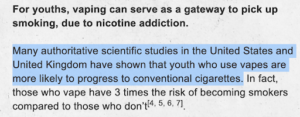Il est surprenant, voire inquiétant, de retrouver les mêmes vieux arguments anti-vapotage dans un communiqué de presse du ministère de la Santé singapourien datant de juillet 2013. Plus de dix ans après, on entend encore les mêmes affirmations, malgré de nombreuses études démontrant que le vapotage est moins nocif que le tabagisme et efficace comme outil de sevrage tabagique. Voici un aperçu de certains arguments obsolètes qui ont la vie dure :

En 2013, le ministère a déclaré, “ Nous restons prudents car il n’existe aucune preuve scientifique concluante démontrant l’efficacité des cigarettes électroniques pour aider les fumeurs à arrêter de consommer du tabac. ” Cela vous rappelle quelque chose ? Malheureusement, le ministère de la Santé de Singapour… continue à affirmer cela aujourd'hui, affirmant que “ Les fumeurs qui utilisaient des cigarettes électroniques pour les aider à arrêter de fumer avaient moins de chances de réussir que ceux qui utilisaient des aides pharmaceutiques ou aucun produit. ” Il est étonnant que dix années de recherche, y compris des études démontrant l'efficacité du vapotage, semblent n'avoir eu aucun impact.

Voici quelques résultats récents :
- Aycock et al. (2023) L'étude a révélé que les personnes qui utilisent le vapotage spécifiquement pour arrêter de fumer présentent des taux d'abstinence à un an plus élevés que celles qui l'utilisent pour d'autres raisons.
- Hajek et al. (2019) ont conclu que le vapotage est deux fois plus efficace que les thérapies de remplacement de la nicotine (TRN) traditionnelles pour le sevrage tabagique.
Et ce n'est pas tout. En 2013, Singapour avait averti que “ Les cigarettes électroniques pourraient potentiellement constituer une porte d’entrée vers le tabagisme, en particulier chez les jeunes. ”

Pourtant, dix ans plus tard, des études montrent systématiquement que le vapotage ne constitue pas une porte d'entrée vers le tabagisme. Par exemple :
- Lee, Coombs et Afolalu (2018) L’analyse de quinze études n’a révélé aucune preuve d’un “ effet de passerelle ” et a mis en évidence d’autres facteurs comme l’anxiété et les habitudes tabagiques des parents comme influences clés sur le comportement des jeunes.
- Meza, Jiménez-Mendoza & Levy (2020) L'étude a révélé que les taux de tabagisme chez les jeunes ont diminué malgré l'augmentation du vapotage, le tabagisme chez les adolescents atteignant des niveaux historiquement bas aux États-Unis.
Malgré tout cela, Singapour affirme toujours que “ Les jeunes qui utilisent des cigarettes électroniques sont plus susceptibles de passer aux cigarettes classiques. ”

À ce stade, il est légitime de se demander s'il s'agit d'une ignorance délibérée. Après une décennie de recherches démontrant les bienfaits du vapotage comme alternative plus sûre et outil efficace de sevrage tabagique, il est grand temps que les politiques publiques reflètent la réalité et non des craintes dépassées. Et peut-être que, tant qu'à faire, Singapour pourrait également reconsidérer son interdiction du chewing-gum.
Si vous souhaitez en savoir plus sur le vapotage et la réduction des risques, consultez notre fiche d'information : https://worldvapersalliance.com/harm-reduction-vaping-fact-sheet/








Une réponse